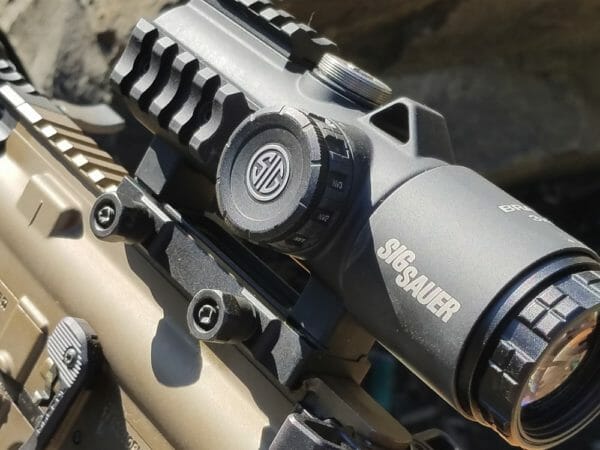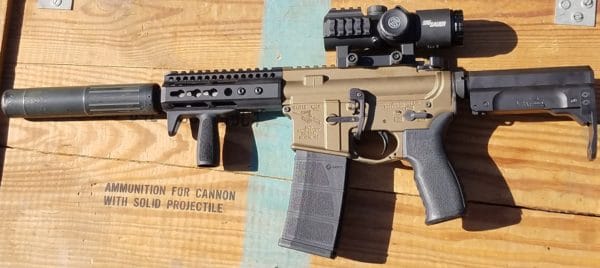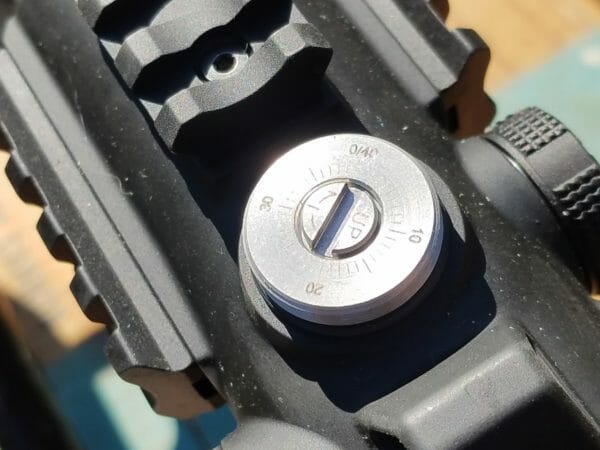
U.S.A. –-(Ammoland.com)- As I line up individual optic features en route to my “ACOG Killer?” showdown, our second stop brings us to Tualitin, Oregon. Here lies the Electro-Optics division of New Hampshire-based Sig Sauer. Kindly willing to send out an optic to be used and abused, I was provided with a Sig Bravo 3 prismatic optic. Let’s take a look at the facts and features of the Bravo 3 before I break down my impressions.
SIG SAUER Bravo 3 Prismatic Optic

Tech Specs:
- Housing: Aluminium
- Magnification: 3x
- Field of view: 10° Megaview (approx 50′ @ 100 yards by my calculations)
- Objective Lens Diameter:24 mm
- Illumination Color: Red
- Reticle: BDC for 5.56mm
- Brightness Settings:11 (3 are for night vision use)
- MOTAC: Motion activated illumination
- Eye Relief:Unlimited
- Adjustment Type:MOA
- Adjustment Click Value:0.5 MOA
- Total windage/elevation travel: 120 MOA
- Three removable picatinny rail sections
- Weight: 22 ounces
- Optical Coating: HDX
- Battery Type: CR2
- Battery Life: 40000 hours
- Operating Temperature: -40 to +140 Fahrenheit
- Water Resistance: IPX-7
- Shockproof/Fogproof: Yes
Ok, so the Bravo 3 is feature-laden. Not unexpected considering Sig’s pedigree. The first thing that really jumped out at me is the “Megaview” feature of a 10° viewing angle. The Bravo 3 does have a generous view field, further enhanced by an excellent lens design that seems to make the black “rim” around the view field nearly disappear. Some other prismatic low magnification optics tested recently seem to have a large dead zone around the view box. The Bravo 3 is edge-to-edge clean, which reduces the tendency of the shooter to focus through the optic at the expense of wider situational awareness.
The o-ring sealed turrets are neither finger-adjustable, nor wired to the optic. Two small features that I’ve come to love over the years. The adjustments however, are both tactile and audible.

The illumination on the reticle gets very, very bright. No worries about being overpowered by a sunny day on this side of the Sahara. While the 11 brightness settings have 3 listed as “NV 1-3”, they’re actually naked-eye visible in the dark. They do work just fine with night vision, in case an IR laser isn’t available.

The reticle itself is effective. The dot inside the horseshoe is very fine, allowing for slow/precise aiming. The horseshoe is big enough to grab the eye quickly, allowing for faster shots. The windage/lead dots are nice, no doubt needed at longer ranges when the wind kicks up. Strangely, there is no manual for the Bravo 3, so I can’t tell you what load the bullet drop compensation (BDC) is calibrated for. As with all BDC’s, it would be nice to have both that information and also the related values in mils/moa so one can figure holdovers for alternate rounds. (EDIT: The reticle subtensions can be found online).

Sig Sauer’s Bravo 3 is only a few finishing touches away from having every base covered. While I’d like to see finger-adjustable turrets and wire retention on the turret caps, consumers need to have information on the reticle to take full advantage of the design. Don’t let minor quibbles scare you off though, the Bravo 3 is a great offering with durability, battery longevity and excellent glass. The Bravo 3 sells for $419.99 on Sig’s site, or for around $310 elsewhere online. Check it out!
For previous entries leading to the “ACOG Killers?”, see:
About Rex Nanorum
Rex Nanorum is an Alaskan Expatriate living in Oregon with his wife and kids. Growing up on commercial fishing vessels, he found his next adventure with the 2nd Bn, 75th Ranger Regt. After 5 tours to Afghanistan and Iraq, he adventured about the west coast becoming a commercial fishery and salvage SCUBA diver, rated helicopter pilot instructor (CFII) and personal trainer, before becoming a gear reviewer and writer.”
